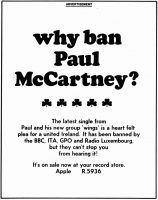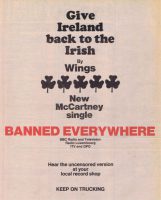In the studio
Wings began recording ‘Give Ireland Back To The Irish’ on 1 February 1972, two days after the Bloody Sunday killings.The session was arranged at short notice, and took place at EMI Studios, Abbey Road.
My wife said ‘Paul’s in the studio. They’ve just phoned up; you’ve got to go in!’ I actually remember walking down from the Tube station and crossing the zebra crossing and hearing the immense sound coming out of Abbey Road. It was that loud!It was rather a tense session but full of energy and Paul chose to finish it with Glyn Johns at another studio.
Paul McCartney Recording Sessions (1969-2013), Luca Perasi
The follow-up session most likely took place at Apple Studio, again in early February 1972, where Glyn Johns mixed the song for release.
The b-side of the single was titled ‘Give Ireland Back To The Irish’ (Version). It was an instrumental version of the song with additional guitar and Irish penny whistle.
The instrumental solved two problems: providing another tune for the flipside of the single; and allowing radio presenters an alternative if, as expected, the main song was banned.
The release
‘Give Ireland Back To The Irish’ was rush released by EMI within a month of its recording, though not without some resistance from the label.
I wasn’t really into protest songs – John had done that – but this time I felt that I had to write something, to use my art to protest. I wrote ‘Give Ireland Back To The Irish’, we recorded it and I was promptly phoned by the chairman of EMI, Sir Joseph Lockwood, explaining that they wouldn’t release it. He thought it was too inflammatory. I told him that I felt strongly about it and that they had to release it, and he said, ‘Well, it’ll be banned.’ And of course it was – the BBC could not play it. But it was number one in Ireland, and in Spain for some reason. It was just one of those things you have to do in life, because you believe in the cause. And protest was in the context of the times.
Wingspan: Paul McCartney’s Band On The Run
Sir Joseph was correct. The BBC did ban ‘Give Ireland Back To The Irish’ on 10 February 1972, two weeks prior to the 25 February release date in the UK. It was also banned by the ITV network and Radio Luxembourg.
The ban did, however, help the song’s profile, at a time when Wings needed all the publicity they could get. It reached number 16 on the UK singles chart.
The single was released on 28 February in the USA, where it peaked at number 21 on the US US Billboard Hot 100, and 38 on the Cash Box Top 100.
The single topped the charts in Ireland and Spain. It reached number 46 in Canada, and 31 in Japan.
‘Give Ireland Back To The Irish’ was one of the few songs played by Wings on their debut tour of English universities.
We didn’t many songs. To be precise, we had eleven, which – at about three minutes a song – is a 33 minute act. They wanted longer so we repeated things. ‘We’ve had a request to do ‘Lucille’. We did it earlier but now we’re gonna do it again for Jenny Babford on the science course.’ Whatever. We just repeated things, especially our new single ‘Give Ireland Back To The Irish’. TThe gigs went quite well but it’s funny to look back and realise that we had such little material.
Wingspan: Paul McCartney’s Band On The Run
The song’s sentiments were not universally supported, however, and resulted in aggression against one Wings family member.
I knew ‘Give Ireland Back To The Irish’ wasn’t an easy route, but it just seemed to me to be the time. I had to say something. All of us in Wings felt the same about it. But Henry McCullough’s brother, who lived in Northern Ireland, was beaten up because of it. The thugs found out that Henry was in Wings.
Wingspan: Paul McCartney’s Band On The Run
‘Give Ireland Back To The Irish’ was first released on compact disc in 1993, as a bonus track on a reissue of Wild Life.
McCartney initially wanted to include it on the 2001 compilation Wingspan: Hits And History, but agreed to drop it after a number of republican terrorist attacks in London in 2000 and 2001.




